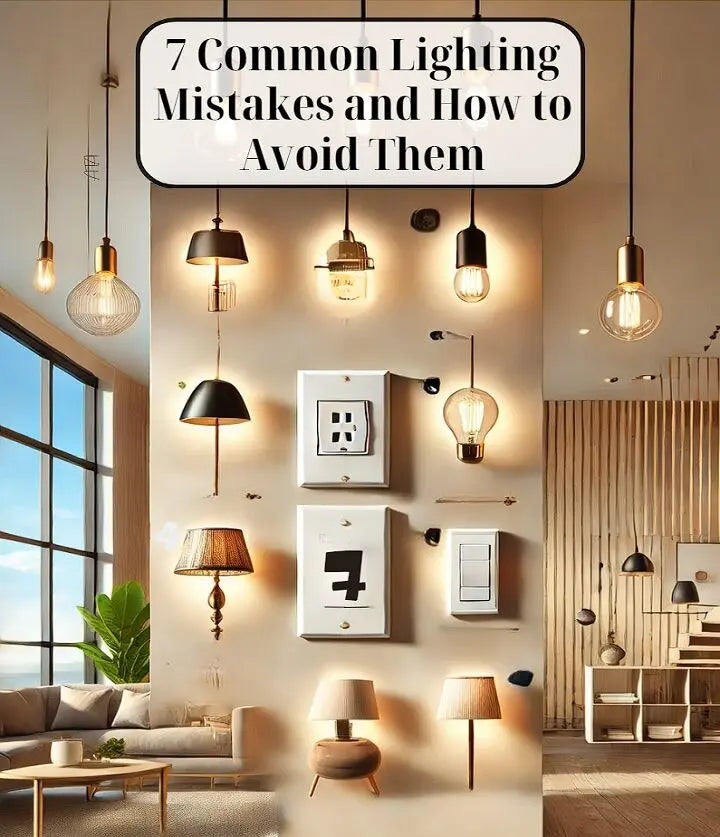
The lighting in your home can make or break the ambiance. Poorly lit spaces tend to feel cold, menacing, and uninviting. The role of lighting in your home for both functional and aesthetic roles can’t be overstated. It can also affect your health and mood. Unfortunately, most homeowners don’t know how to correctly incorporate lighting into their spaces.
This article highlights seven common lighting mistakes to avoid in your home.
Common Lighting Mistakes to Avoid
Every home requires a variety of light configurations that may vary depending on its design. However, they should be tailored to meet the homeowner’s needs. Any mismatch can result in a poor light scheme which can affect the atmosphere in the space. Listed below are seven common lighting mistakes you should avoid.
1. Insufficient Lighting

Over-reliance on one lighting source especially in large spaces is a mistake that almost all homeowners make. This lighting design tends to cast shadows and results in uneven illumination. The best approach to use in your home is layered lighting.
Merging ambient, task, and accent lighting in a space can significantly elevate its look and feel. Whether you opt for recessed-lights in addition to an overhead chandelier in the space or choose to include some strip lighting for the perfect dreamy atmosphere, you can never go wrong with layered lighting.
2. Choosing a Wrong Light Fixture Size
You find a light fitting of your dreams and hurry to add it to the cart without considering the space’s dimension only to get home and find out that it doesn’t work. Sounds familiar? This scenario is especially common for homeowners looking for statement pieces like pendants and chandeliers.
A light fixture that’s too large can make a small space appear overwhelming. Alternatively, a smaller fitting will make a large room feel uncomfortable and underwhelming. Understanding how to choose the right light size will help you select the right fixture for your home. Key aspects to consider are the ceiling height and size of the space.
3. Overlooking the Power of LED Lighting
Most homeowners tend to ignore this new lighting technology. Worse, some of them purchase LEDs that don’t have dimmer switches. These light fixtures provide several cost-cutting benefits thanks to their energy-efficient, durable, and powerful design. Adding them to your home’s lighting design plan ensures you enjoy excellent color accuracy in your space. Just remember to buy dimmable ones so you can adjust your lighting as desired.
4. Poor Three-way Switch Setup

A three-way switch allows you to connect multiple wires to different switches that control on light. This electrical connection is ideal for common rooms like the living room and dining room. The wrong planning inconveniences most homeowners because you can’t easily access the lighting from a different area in the home.
Hiring reputable and certified technicians can help you avoid this issue. To resolve it, you can redo your home wiring or install smart light switches to create a virtual connection within your home electrical system.
5. Limited Three-way Connections in The House

You’ve got your three-way plan correct but they aren’t enough. This is another common mistake that homeowners make. One golden rule is to always have three-way connections in large rooms, foyer, and stairways in the home.
You can use smart light switches and dimmers to solve this issue. However, you can also opt to redo your home wiring. Ensure you take into account your home’s configuration to avoid having endless three-way connections lying around.
6. Poor Quality Dimmers
Investing in a home’s interior design plan can be costly. But trying to cut costs by purchasing substandard dimmers is a mistake. Remember, cheap is expensive. There’s nothing truer than this when it comes to selecting dimmers for your home. Not only, is the lifespan shorter but the poor craftsmanship is also evident. Controlling the light intensity can also be difficult with these designs.
You can always take your time when trying to light up your home. Try and save up for quality dimmers to enjoy better lighting in your space.
7. Wrong Switch and Dimmer Placement

A common mistake that most homeowners make is placing a switch too close to the thermostat. Most electrical components tend to produce heat. Placing these two fittings close can significantly affect performance due to erroneous readings. A thermostat shouldn’t go above a switch. Make sure to place a reasonable distance between the two at all times.
Basic Principles of Good Lighting
Understanding the different qualities of light can guide you on how best to use them. It can also help you avoid common lighting mistakes in the home. Listed below are some of the principles you should consider for your home lighting design plan.
- Intensity: This is an indicator of the power and brightness of your light source. And, it’s not affected by the size of the space. The intensity of the light design you choose is bound to vary depending on the room you want to install the fitting.
- Visibility: The ability of the light design to pique the interest of those in the space is one of the determinants of good lighting. Do you want to tone down the mood for a relaxed atmosphere in the bedroom or want more focused light for a lively hosting experience in the living room? Your light’s visibility is the perfect mood setter.
- Form and Distribution: Lighting plays a functional role and how you use it can significantly impact the space. Direct beam lights are ideal for improved focus while general light is great for balanced illumination.
- Color: Knowing which light temperature to go for is essential in deciding the right bulb for your space. Different rooms in the home work well with varying colors. Most living room spaces go well with warm lights while areas like a kitchen island require white light to enhance clarity.
- Direction and Movement: Light has direction and its movement changes depending on its color, form, and intensity fluctuation. Carefully studying these properties will help you achieve good lighting choices for your home.
Create the Perfect Ambiance With the Right Home Lighting Design
Good lighting can be the missing puzzle in your home. It offers the perfect finishing touch to decorating your space and turning it into a lively and warm space. But, it’s installation should be done correctly. Avoiding the mistakes listed in this article guarantees a better ambiance in your home. You can also use the solutions highlighted to fix some of the common issues. It’s time to enjoy your space. To avoid mistakes in lighting selection, you can benefit from Seus Lighting's free architectural and technical support. Contact us for more information.

